The Samsung SSD 850 120GB Review: A Little TLC for SATA
by Billy Tallis on November 27, 2017 12:00 PM ESTRandom Read Performance
Our first test of random read performance uses very short bursts of operations issued one at a time with no queuing. The drives are given enough idle time between bursts to yield an overall duty cycle of 20%, so thermal throttling is impossible. Each burst consists of a total of 32MB of 4kB random reads, from a 16GB span of the disk. The total data read is 1GB.

The Samsung SSD 850 120GB has a significantly slower random read speed than its predecessors from Samsung, but it is still faster than any other brand. The Micron 3D TLC-based SSDs that are actually currently for sale are the three slowest drives on this test.
Our sustained random read performance is similar to the random read test from our 2015 test suite: queue depths from 1 to 32 are tested, and the average performance and power efficiency across QD1, QD2 and QD4 are reported as the primary scores. Each queue depth is tested for one minute or 32GB of data transferred, whichever is shorter. After each queue depth is tested, the drive is given up to one minute to cool off so that the higher queue depths are unlikely to be affected by accumulated heat build-up. The individual read operations are again 4kB, and cover a 64GB span of the drive.
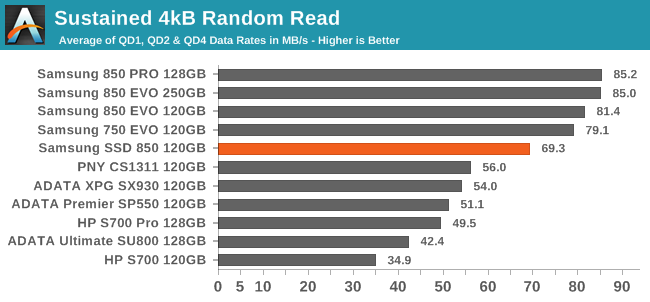
On the longer random read test that brings in higher queue depths, the rankings are almost unchanged. The 850 120GB is Samsung's slowest, but everyone else is much slower.
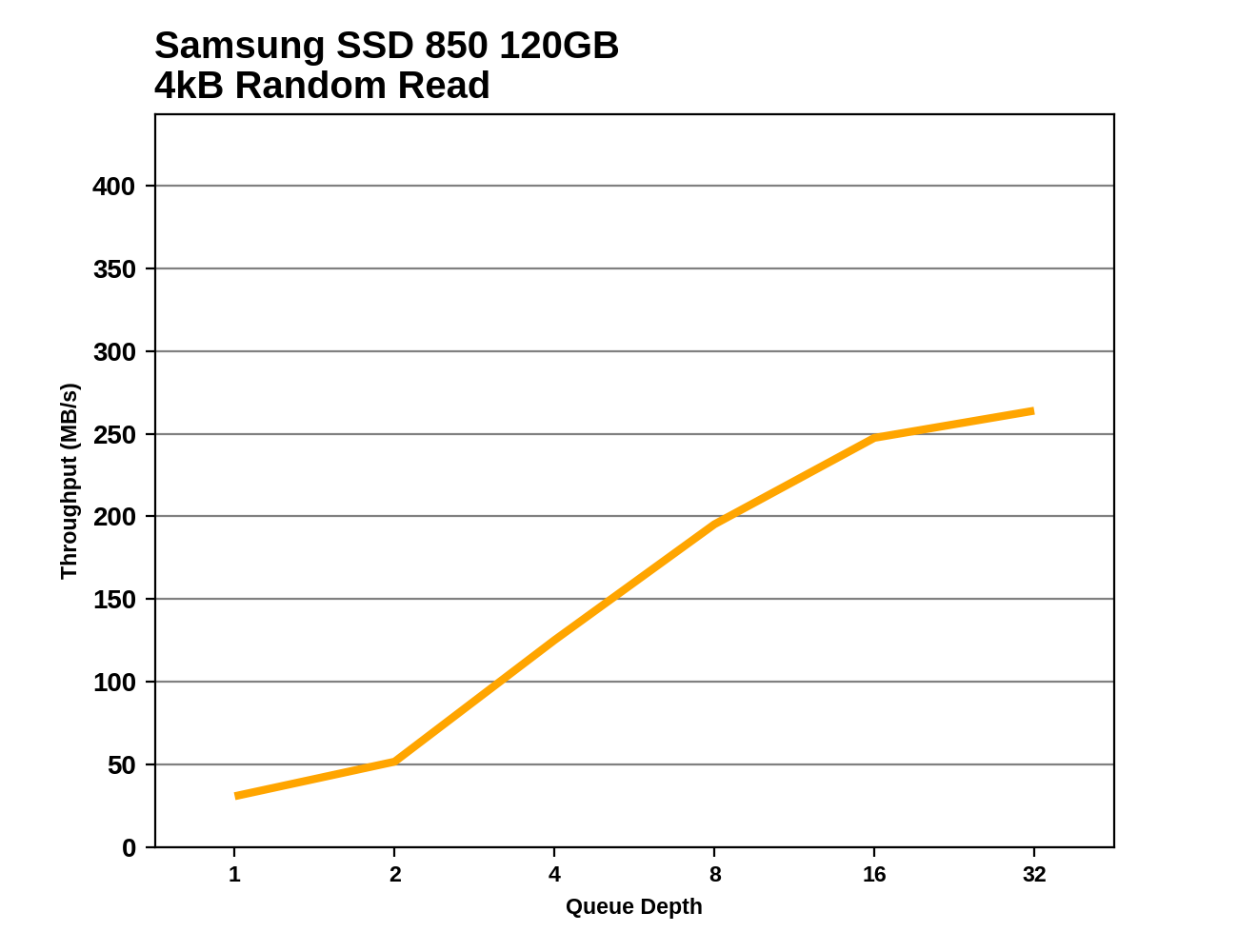 |
|||||||||
At higher queue depths, the Samsung drives scale up to much higher performance levels than the competing 120GB-class SSDs. The 850 is still the slowest of Samsung's drives and it falls short by more than 100MB/s at QD16 and higher, but by that point the 850 is 2.5 times faster than the quickest Micron 3D TLC-based drive.
Random Write Performance
Our test of random write burst performance is structured similarly to the random read burst test, but each burst is only 4MB and the total test length is 128MB. The 4kB random write operations are distributed over a 16GB span of the drive, and the operations are issued one at a time with no queuing.
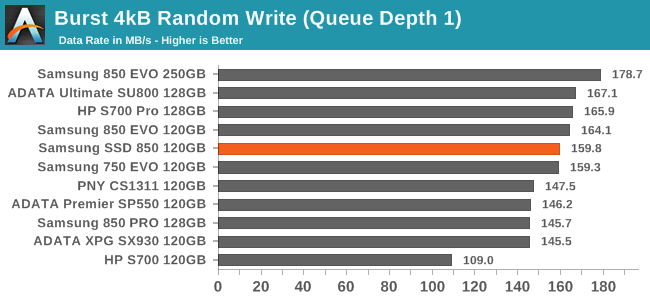
There aren't huge disparities between the 120GB-class SSDs on the burst random write test, save for the DRAMless HP S700. The Samsung SSD 850 is only slightly slower than the old 850 EVO, but two of the drives using Micron 3D TLC come out on top for this test.
As with the sustained random read test, our sustained 4kB random write test runs for up to one minute or 32GB per queue depth, covering a 64GB span of the drive and giving the drive up to 1 minute of idle time between queue depths to allow for write caches to be flushed and for the drive to cool down.
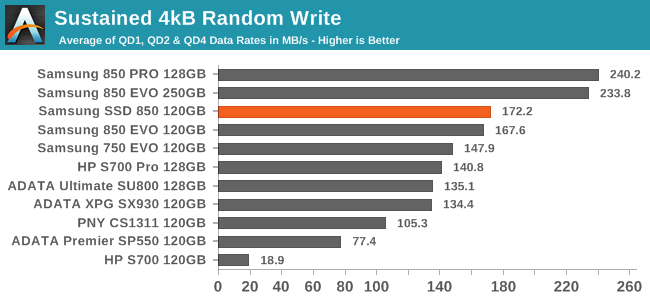
With a longer test duration that will tend to fill the whatever SLC write cache such a small drive can include, the old Samsung 850 PRO 128GB is unsurprisingly the winner by a wide margin. The Samsung 850 comes in second place and slightly ahead of the old 850 EVO, somewhat corroborating Samsung's claims that their 64L 3D TLC offers improved write performance.
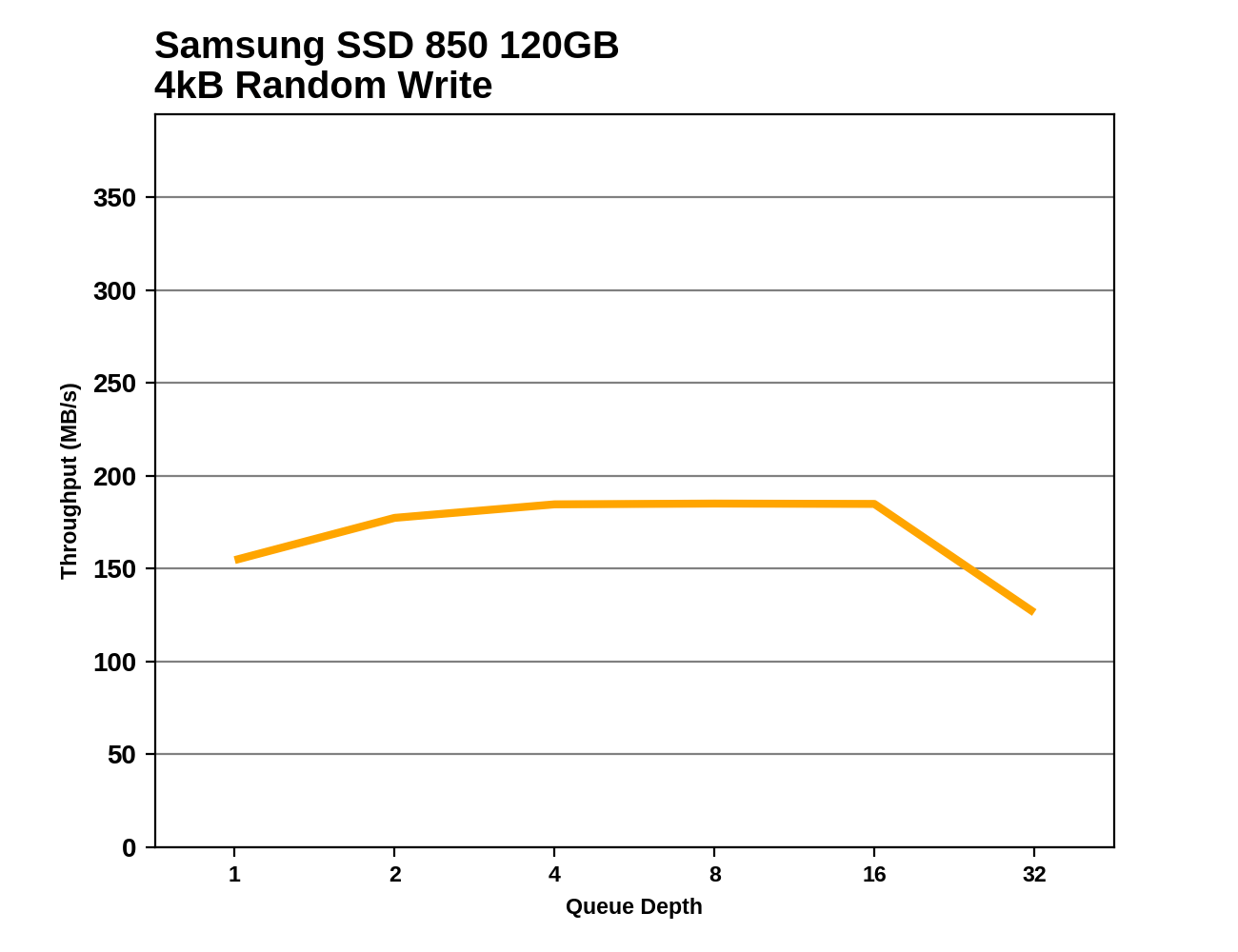 |
|||||||||
The performance of the Samsung 850 holds up through most of the random write test, but doesn't improve significantly as queue depths grow. By the end of the test, the drive has fallen behind on garbage collection despite the idle time it is allowed between queue depths, and performance drops off. Most of the other drives suffer a similar fate at some point during the test; the 750 EVO is the fastest drive that doesn't show a precipitous drop at any point. The Samsung 850 PRO was still faster than the rest even after its spare area was filled and it was forced to perform garbage collection through the later parts of the test.










31 Comments
View All Comments
Kristian Vättö - Monday, November 27, 2017 - link
There are still MLC based enterprise SSDs from Samsung, such as SM863a.yifu - Saturday, December 2, 2017 - link
also Toshiba hk4rqlum - Monday, November 27, 2017 - link
For the pc's at work I always use 120gb ssd's as they offer enough capacity and are still about €20 cheaper then 200gb+ drives.bug77 - Tuesday, November 28, 2017 - link
I'm not sure giving up 80GB (40%) space to save €20 is the right choice. Remember, these things don't like being full and people tend to save a lot of junk of their drives.That said, the smallest SSD is still way better than the fastest HDD. (Have you ever seen Win10 trying to patch itself while installed on a HDD?)
ads295 - Tuesday, November 28, 2017 - link
I think that's why laptops started skipping on the HDD activity LED from as early as when Win8 was available.bcronce - Tuesday, November 28, 2017 - link
Great for my firewall. I only need ~4GiB of space.Glaurung - Tuesday, November 28, 2017 - link
"Remember, these things don't like being full and people tend to save a lot of junk of their drives."For situations where the drive is never going to be full and you just need the cheapest possible SSD, it's fine. For instance, My spouse writes reports for a living, and she has never come anywhere near to filling up the 40gb X25-V on her work laptop. (no music, no pictures, no videos, just documents and PDFs and audio recordings that she refers to and then deletes when the report gets final client approval).
pixelstuff - Monday, November 27, 2017 - link
We've been missing the 128GB 850 Pro model with it's 10 year warranty, which usually cost about $90. We were using it in single task devices such as DVRs with secondary data drives. Having to move to the 256GB 850 Pro just meant we had to spend an extra $30+ for no extra benefit, and unfortunately those 256GB drives never dropped to the $90 price range.mapesdhs - Wednesday, November 29, 2017 - link
Pricing did drop that low at one point; in the UK the 850 EVO 250GB was 53 UKP from Amazon and not much more elsewhere (meanwhile, 500GB pricing was slowly heading down to 100 UKP), but then after a blowout sale of several thousand 850 EVO 500GB units by one retailer in two weeks at around 115 UKP each (I bought two), I'm sure Samsung realised they simply didn't need to sell their tech so cheap, prices went up, and all the other vendors followed suit. Also, when new models came out, old models were almost immediately removed from seller sites, sometimes on the same day. Since then, pricing has almost doubled, there's just no need for the manufacturers to offer low pricing when they can easily sell everything they make due to OEM demand. It's ironic that the nature of that demand is largely by a consumer demographic that treats tech as thoroughly disposable, and often has little regard for what it is or how it works.The more I see new products like this being worse than old products, the more I'm impressed with what Intel has done with Optane, etc. At least Intel has actually done something new, whereas Samsung seems to have done what Intel did with its CPU-based strong position, ie. sat on its butt for several years while the cash rolled in and not bothered to innovate. Have to wonder why Samsung couldn't have brought ought something like Optane ages ago, and for the consumer market, not just Enterprise. Yes there's a shift towards NVMe, but it's not that big yet (with warranties 50% shorter and insane price hikes on retail versions), and a lot of consumers just want capacity with decent quality. At this point a 4TB SATA SSD with the quality level of the 850 EVO would sell very well if sensibly priced, but nobody's even trying, they're still having fun selling low capacity models (why sell one 4TB when one can make a lot more selling twenty 120GB units). I remember SanDisk promised to have an 8TB model by now, but that never happened.
Billy, add the old 840 and 840 Pro into those results charts, I bet this new 850 wouldn't look so impressive, ditto if other old models were included too like the Vertex 4, Vector, Neutron GTX, etc. Heck, even the old 830 would likely put most of the modern non-Samsung models to shame (ditto something as ancient as a Vertex3, and it'd be hillarious too see where the budget Agility3/4 would fit in the charts today). SATA SSDs have become like CPUs before Ryzen finally launched, the tech has stagnated or even gone backwards. The 750 was touted as a cheaper 850 EVO, but in reality it became more expensive. I get that the nature of parallelism in NAND means larger dies don't offer the performance at lower capacities, but then that's why it would make sense to create something genuinely new; Intel needed a good poke in the ribs from Ryzen to get moving again with its CPU line, but at least it *did* something with respect to developing new storage tech.
Ian.
WithoutWeakness - Monday, November 27, 2017 - link
First section header in the introduction: The *Samung* SSD 850"